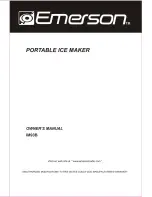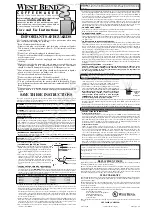
13
• There are 2 spoons provided to cover all
combinations of quantities in the recipes.
Tablespoon tbsp, teaspoon and
1/
2
teaspoon
(marked with line) and a
1/
4
tsp.
1tsp = 5 millilitres
1 tbsp = 3 tsp = 15 millilitres
Hint measure dry ingredients first with the
tablespoon, then wet (oil) last.
Your breadmaker produces delicious baked goods
with ease. This machine requires only that you carefully
follow the recipe instructions. In basic cooking,
normally ‘a pinch of this and a dash of that’ is fine, but
not for breadmakers. Using an automatic breadmaker
requires you accurately measure each ingredient for
best results.
Ingredient temperatures
All ingredients, including the machine and pan,
and especially liquids (water or milk), should be
warmed to room temperature 21°C (70°F). If
ingredients are too cold, below 10°C (50°F), they will not
activate the yeast. Extremely hot liquids, above 45°C
(113°F), may kill the yeast.
Creating your own yeast bread
With the breadmaker, even the most inexperienced
baker can achieve the satisfying experience of baking a loaf
of bread. All of the mystery and hard work is gone. Inside
this talented machine with an electronic brain, the dough is
mixed, kneaded, proofed and baked without you being
present. The automatic breadmaker can also just prepare
the dough, and when it's ready, you shape, allow to rise
and bake in a conventional oven. The recipes on the
following pages are ‘tailored’ for this breadmaker. Each
recipe features ingredients that best compliment a
particular loaf of bread, and each was tested in our
machines. It is extremely important not to exceed the
amounts of flour specified in each of the recipes or
else it could result in unsatisfactory baking
performance. When creating your own yeast bread
recipes or baking an old favourite, use the recipes in this
cookbook as a guide for converting portions from your
recipe to your breadmaker. Do not exceed 4 cups of flour
and
1/
2
cup fruit and nut.
Special glazes for yeast breads
Give your just baked bread a professional finish.
Select one of the following special glazes to enhance
your bread.
Egg glaze
Beat 1 large egg and 1 tablespoon of water
together, brush generously. Note: apply only to
doughs before baking.
Melted butter crust
Brush melted butter over just baked bread for a
softer, tender crust.
Milk glaze
For a softer, shiny crust, brush just baked bread
with milk or cream.
Sweet icing glaze
Mix 1 cup sifted icing sugar with 1 to 2 tablespoons of
milk to make a glaze consistency and drizzle over raisin
bread or sweet breads.
Poppy/Sesame/Caraway seed/Oatmeal
Sprinkle your choice of these seeds generously
over just glazed bread.
Other tips when making dough
• Place all recipe ingredients into the baking pan so
that yeast is not touching any liquid.
• After completing the process of making dough in
your breadmaker, typically when letting dough rise
outside the breadmaker, allow 30 minutes or until
dough doubles in size. Dough should be lightly
greased and covered with grease proof paper and a
dry towel. It should be placed in a warm area free
from drafts.
• Humidity can cause problems, therefore humidity
and high altitudes require adjustments. For high
humidity, add an extra tablespoon of flour if
consistency is not right. For high altitudes, decrease
yeast amount by approximately
1/4
teaspoon, and
decrease sugar and/or water or milk slightly.
• The DOUGH setting is great for mixing, kneading
and proofing (allowing dough to rise). Use the
automatic breadmaker to prepare this dough.
• When recipes call for a ‘lightly floured surface,’ use
about 1 to 2 tablespoons of flour on the surface.
You may want to lightly flour your fingers or rolling
pin for easy dough manipulation.
• When you let dough ‘rest’ and ‘rise’ according to a
recipe, place it in a warm, draught-free area. If the
dough does not double in size, it may not produce
a good texture.
• If the dough you are rolling shrinks back, let it rest
covered for a few minutes before rolling again.
• Dough may be wrapped in plastic and stored in a
freezer for later use. Bring the dough to room
temperature before using.
• After 5 minutes of kneading, open the lid and check
the dough consistency. The dough should form a
soft, smooth ball. If too dry, add liquid. If too wet,
add flour (
1/
2
to 1 tablespoon at a time).
• When using honey, malt extract, golden syrup or
treacle, coat the spoon or cup with oil first, this will
prevent these ingredients from sticking, to the
spoon or cup.














































